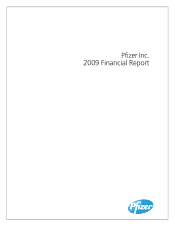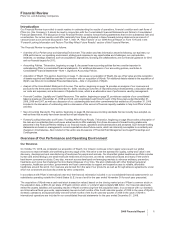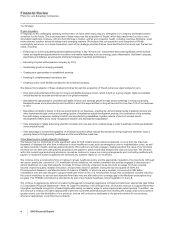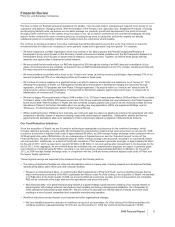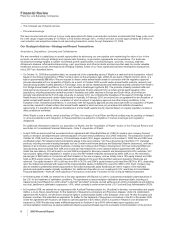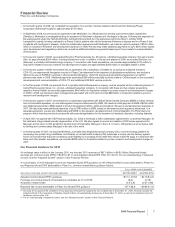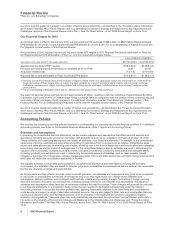Pfizer 2009 Annual Report Download - page 11
Download and view the complete annual report
Please find page 11 of the 2009 Pfizer annual report below. You can navigate through the pages in the report by either clicking on the pages listed below, or by using the keyword search tool below to find specific information within the annual report.
Financial Review
Pfizer Inc. and Subsidiary Companies
Contingencies
We and certain of our subsidiaries are involved in various patent, product liability, consumer, commercial, securities, environmental,
and tax litigations and claims; government investigations; and other legal proceedings that arise from time to time in the ordinary
course of our business. Except for income tax contingencies, we record accruals for contingencies to the extent that we conclude
their occurrence is probable and that the related liabilities are estimable, and we record anticipated recoveries under existing
insurance contracts when assured of recovery. For tax matters, we record accruals for income tax contingencies to the extent that
we conclude that a tax position is not sustainable under a “more-likely-than-not” standard and we record our estimate of the potential
tax benefits in one tax jurisdiction that could result from the payment of income taxes in another tax jurisdiction when we conclude
that the potential recovery is more likely than not (see Notes to Consolidated Financial Statements—Note 7D. Taxes on Income: Tax
Contingencies). We consider many factors in making these assessments. Because litigation and other contingencies are inherently
unpredictable and excessive verdicts do occur, these assessments can involve a series of complex judgments about future events
and can rely heavily on estimates and assumptions.
Acquisitions
Our consolidated financial statements include an acquired business’s operations after the completion of the acquisition. We account
for acquired businesses using the acquisition method of accounting. The acquisition method of accounting for acquired businesses
requires, among other things, that most assets acquired and liabilities assumed be recognized at their fair values as of the
acquisition date and that the fair value of acquired in-process research and development (IPR&D) be recorded on the balance sheet.
Also, transaction costs are expensed as incurred. Any excess of the purchase price over the assigned values of the net assets
acquired is recorded as goodwill. For acquisitions consummated prior to January 1, 2009, amounts allocated to acquired IPR&D
were expensed at the date of acquisition. When we have acquired net assets that do not constitute a business under accounting
principles generally accepted in the United States of America (U.S. GAAP), no goodwill has been recognized.
Fair Value
We often are required to measure certain assets and liabilities at fair value, either upon initial measurement or for subsequent
accounting or reporting. For example, we use fair value extensively in the initial measurement of net assets acquired in a business
combination and when accounting for and reporting on certain financial instruments. We estimate fair value using an exit price
approach, which requires, among other things, that we determine the price that would be received to sell an asset or paid to transfer
a liability in an orderly market. The determination of an exit price is considered from the perspective of market participants,
considering the highest and best use of assets and, for liabilities, assuming the risk of non-performance will be the same before and
after the transfer. Many, but not all, of our financial instruments are carried at fair value. In addition, as required under accounting
rules for business combinations, most of the assets acquired and liabilities assumed from Wyeth on October 15, 2009 have been
recorded at their estimated fair values as of the acquisition date. For additional information on the valuation approaches allowed
under U.S. GAAP to determine fair value, including a description of the inputs used, see Notes to Consolidated Financial
Statements—Note 1F. Significant Accounting Polices: Fair Value. Also, for information on the use of fair value for our financial
instruments, see Notes to Consolidated Financial Statements—Note 9. Financial Instruments.
Revenues
Revenue Recognition—We record revenues from product sales when the goods are shipped and title passes to the customer. At the
time of sale, we also record estimates for a variety of sales deductions, such as rebates, discounts and incentives, and product
returns. When we cannot reasonably estimate the amount of future product returns, we record revenues when the risk of product
return has been substantially eliminated. We record sales of certain of our vaccines to the U.S. government as part of the Pediatric
Vaccine Stockpile program; these rules require that for fixed commitments made by the U.S. government, we record revenues when
risk of ownership of the completed product has been passed to the U.S. government. There are no specific performance obligations
associated with products sold under this program.
Deductions from Revenues—As is typical in the biopharmaceutical industry, our gross product sales are subject to a variety of
deductions that generally are estimated and recorded in the same period that the revenues are recognized and primarily represent
rebates and discounts to government agencies, wholesalers, distributors and managed care organizations with respect to our
biopharmaceutical products. These deductions represent estimates of the related obligation and, as such, judgment and knowledge
of market conditions and practice are required when estimating the impact of these sales deductions on gross sales for a reporting
period.
Specifically,
•In the U.S., we record provisions for pharmaceutical Medicaid, Medicare and contract rebates based upon our experience ratio of
rebates paid and actual prescriptions written during prior quarters. We apply the experience ratio to the respective period’s sales to
determine the rebate accrual and related expense. This experience ratio is evaluated regularly to ensure that the historical trends are
as current as practicable. As appropriate, we will adjust the ratio to better match our current experience or our expected future
experience. In assessing this ratio, we consider current contract terms, such as changes in formulary status and discount rates. If our
ratio is not indicative of future experience, our results could be materially affected.
•Outside the U.S., the majority of our pharmaceutical rebates, discounts and price reductions are contractual or legislatively mandated,
and our estimates are based on actual invoiced sales within each period; both of these elements help to reduce the risk of variations in
the estimation process. Some European countries base their rebates on the government’s unbudgeted pharmaceutical spending, and
we use an estimated allocation factor (based on historical payments) and total revenues by country against our actual invoiced sales to
project the expected level of reimbursement. We obtain third-party information that helps us monitor the adequacy of these accruals. If
our estimates are not indicative of actual unbudgeted spending, our results could be materially affected.
•Provisions for pharmaceutical chargebacks (primarily reimbursements to wholesalers for honoring contracted prices to third parties)
closely approximate actual as we settle these deductions generally within two to five weeks of incurring the liability.
2009 Financial Report 9

